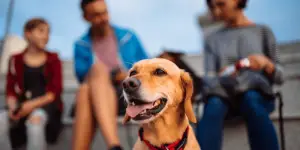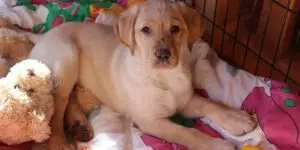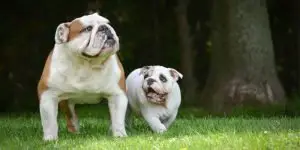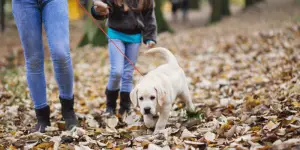
10-Week-Old Puppy Development – What to Expect
Caring for a 10-week-old puppy can certainly be a bit of hard work as a lot has changed since your pooch was 8 weeks or even 6 weeks of age.
In addition to being more adventurous (and mischievous), a 10-week-old puppy is now older enough to learn some basic training and go on walks. However, it’s not all smooth sailing – there’s also a lot more chewing, biting, rebellion, and the dreaded fear period.
Don’t worry, our handy guide on 10-week-old puppy development will guide you through each step of your puppy’s care so you know what to expect.
10-week-old puppy schedule
Creating a schedule for your 10-week-old puppy can help you settle them into a routine so they know what to expect each day. This can assist with training and also help you set some bonding time for your puppy each day.
If you’re not sure what to include in your pup’s schedule, here’s an example of one you could use. During any gaps in your puppy’s schedule when you are free, be sure to fill it with activities like training and play sessions!
| Time of day (Hour) | Activity |
|---|---|
| 7am | Potty break. |
| 8am | Breakfast, potty and activity. |
| 10am | Potty break and sleep. |
| 12pm | Meal, potty, break, and activity. |
| 3pm | Nap |
| 4pm | Potty break and activity. |
| 5pm | Meal and activity. |
| 7pm | Nap |
| 8pm | Potty break and activity until bedtime. |
| 10pm | Potty break and bedtime. |
| 2am | Potty break |
10-week-old puppy sleep schedules
Dogs have similar sleep patterns to humans, but instead of being monophasic sleepers, they are polyphasic sleepers. This means they sleep in small bursts throughout the day rather than in one long stretch in the evening.
Canines normally only sleep for 45 minutes in one sitting, with around 6 minutes of that time spent in the REM (Rapid Eye Movement) stage. This phase usually occurs about 20 minutes after your puppy has dozed off.
Most dogs will begin dreaming at this point, so you might notice signs like rapid breathing, twitching, and eyelids flickering. During a nap, dogs will cycle between non-REM sleep and REM sleep twice.
Your pooch will be difficult to stir from their slumber while in the REM phase, and doing so may cause them to react aggressively. It’s best to leave a dog well alone while they are resting, but if you need to wake your pup up, gently call their name or softly tap them on the rear.
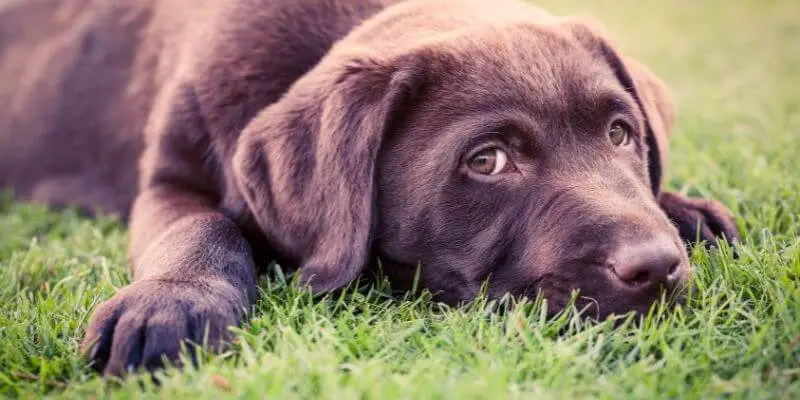
How much sleep does a 10-week-old puppy need?
While it can certainly seem that a 10-week-puppy is constantly on the rampage, they actually spend the majority of the day asleep. All puppies need ample rest to regain their energy levels and develop healthily, especially those that are under 6 months old.
A 10-week-old pup requires between 18 to 20 hours of sleep daily. It’s not uncommon for puppies to twitch, whine, or even bark during a nap. This is completely normal and is simply a sign of REM sleep.
Dogs only spend roughly 10% of their napping time in REM sleep as they have irregular sleep patterns. However, puppies tend to stay in this phase for slightly longer, as well as experience side effects like twitching, crying, barking, etc, more frequently due to their brains being undeveloped
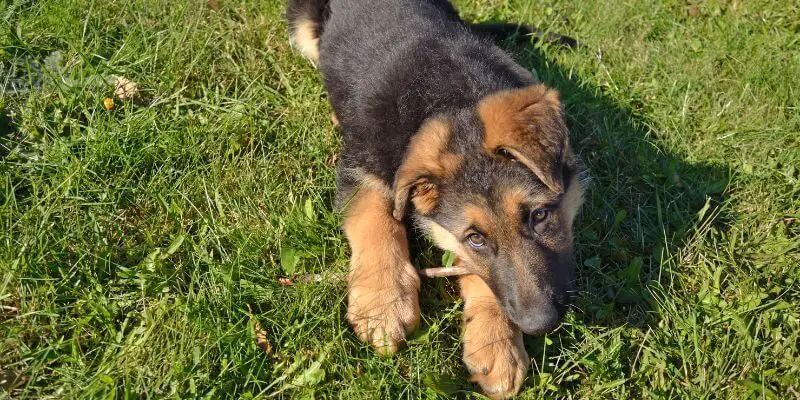
10-week-old puppy training
Although puppies at 10 weeks of age will be a long way off from being fully housebroken and well-trained, they’re still able to learn the basics. If you haven’t done so already, get your puppy accustomed to using a crate to sleep in.
Not only will this make potty training your puppy considerably easier, but the crate will also act as a safe retreat for your pup that they can access when they feel threatened or stressed. Better yet, you’ll have a secure area to place your pooch when you can’t keep an eye on them.
Alongside crate training, you can also start introducing your puppy to wearing a harness/leash, being groomed, and even some basic commands like “sit” and “wait”. While it’s tempting to start housebreaking your puppy as soon as possible, it’s best to wait until they are at least 12 weeks of age as they will have better control of their bladder.

The Vet's top training tip - 10 week old puppies
"10 weeks is a really great time to get to work on some solid training. By now, your pup has gotten used to you and your home and will be a lot more responsive and obedient. Be sure to use a positive, reward based method that includes plenty of praise and treats. Remember, punishing your puppy when they get it wrong is more likely to result in anxiety and bad behaviour than anything else."
- Dr Linda Simon MVB MRCVS
10-week-old puppy behavior
Puppies at 10 weeks old are full of energy, curiosity, and mischief. They are constantly learning and processing new experiences, with much of their exploration done through chewing, biting, and sniffing.
Nothing is safe from your inquisitive companion, so you’ll need to make sure you puppy-proof your home, otherwise, your prized possessions could take a bit of a beating. Anything that you don’t want to be destroyed should be far away from your puppy’s reach, as well as household objects that your pup could potentially ingest.
This includes things like human food, cleaning products, plants, and medication.
Try to discourage your puppy from biting your hands and clothes as this can cause mouthiness in later life. It might be cute now, but it won’t be when your puppy is an adult!
During this stage of development, puppies usually go through a fear period where they become scared of things they were previously accustomed to.
It might seem like they’ve regressed in their training, but don’t worry, this phase is only temporary and usually subsides in a few weeks. A second fear period is also common between 6 to 14 months of age.

How much should a 10-week-old puppy eat?
The amount of food a 10-week-old pup needs depends on the type of food you feed them, as well as their size and energy levels.
Large, athletic breeds will need to consume more food than small, inactive breeds. That being said, the general rule is around 20g of food per kg of weight a day.
You should break up your puppy’s food into 3 or 4 meals spread across the day.
How much water does a 10-week-old puppy need to drink?
Your 10-week-old puppy should have constant access to fresh, clean water to keep them hydrated. The amount they need to drink daily will differ slightly depending on their size, activeness, and whether they’re on a dry or wet food diet.
Dry food has a lower moisture content than wet food, so you’ll need to make sure your puppy is drinking enough water throughout the day. In addition, on hot days, it’s crucial that your puppy stays refreshed to prevent heat stroke, which can be fatal in young dogs.
As a general rule of thumb, your pup should drink between 20 ml to 40 ml of water per pound of body weight. It’s also important to note that you shouldn’t restrict your puppy’s water intake during potty training.
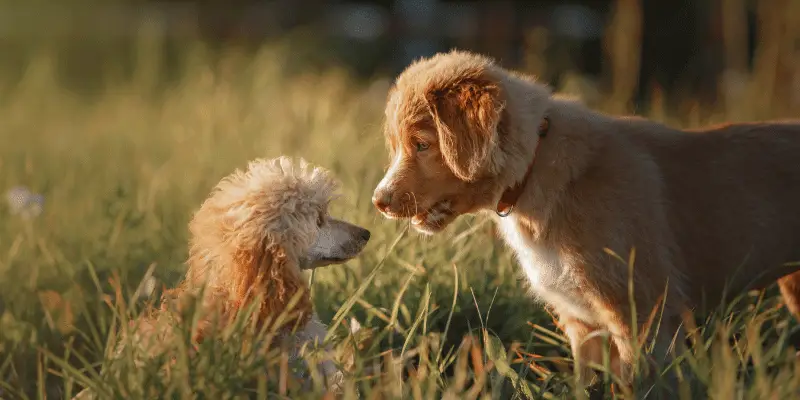
10-week-old puppy socialization
Socialization is one of the most critical stages of puppy training as it will influence the type of dog your pooch will grow into. Introducing your pup to a variety of scenarios, humans, and dogs from an early age will prevent behavioral issues like aggression and fear.
Allow your pooch to meet as many people and dogs as possible (after they’re fully vaccinated!), and introduce them to a range of situations to build their confidence, such as cyclists, cars, roads, pedestrians, loud noises, etc.
However, make sure your puppy has been vaccinated before you let them interact with other dogs
Can my 10-week-old puppy meet other dogs?
Your puppy can meet other (vaccinated) dogs as long as they’ve had both of their vaccinations that protect them from illnesses such as hepatitis, canine distemper, and parvovirus.
10-week-old puppy appearance
Puppies at 10 weeks old look like miniature versions of their adult counterparts, just with softer coats and fewer teeth. Your pup should have all 28 of their deciduous (baby) teeth at this age.
However, once they hit around 12 weeks old, their baby teeth will gradually fall out and be replaced with 42 permanent pearly whites.
10-week-old puppy health and care
In addition to training and a well-balanced diet, puppies need a few other things to keep them in good shape and health, including exercise and grooming.
Daily walks are a requirement for all dogs to maintain peak physical and mental well-being. Puppies don’t need as much exercise as adults, but you should still aim to take your pup for a quick 10-minute walk each day.
As your puppy gets old, you’ll be able to take them on much longer treks.
Alongside ample exercise, your puppy needs regular maintenance of their coat, teeth, nails, and ears. The length and texture of your puppy’s coat will influence the frequency of grooming, with short-haired dogs needing weekly brushing and long-haired canines requiring daily brushing.
Teeth should be brushed a few times a week with a soft-bristle toothbrush and dog-safe toothpaste, whereas ears should be cleaned once a week with cotton wool pads and a pet ear cleanser.
Trim your puppy’s nails every couple of weeks or whenever you hear a clicking sound as they walk, making sure to avoid the quick.
Can I walk my 10-week-old puppy outside?
Provided your puppy has had both of their vaccinations (and 2 weeks have passed since their last injection!), you can walk them outside.
It’s not advised to take your puppy to public spaces until after they’ve been vaccinated as they could catch an infectious illness like canine distemper and parvovirus if they come into contact with an infected dog.
Final thoughts
Caring for a 10-week-old puppy can be quite a big job, especially as they love to explore their surroundings, whether it’s chewing on your laptop charger, gnawing on your furniture, or crawling into spaces that they can’t get back out of.
Alongside watching your curious pup like a hawk, you need to ensure all of their care needs are met, which includes exercise, grooming, a good diet, and making sure they’re up to date with their vaccinations. This age is also a great time to start training your puppy to help them grow into a well-mannered, independent, and happy adult dog.
References
- https://www.livescience.com/53743-dog-dreams.html
- https://vcahospitals.com/know-your-pet/do-dogs-dream
- https://www.akc.org/expert-advice/training/how-to-crate-train-your-dog-in-9-easy-steps/
- https://www.paws.org/resources/how-to-crate-train-your-dog/#:~:text=After%20your%20dog%20enters%20the,process%20several%20times%20a%20day.
- https://www.thelabradorsite.com/10-week-old-puppy/
- https://wagwalking.com/lifestyle/dog-ownership/puppyhood-what-to-expect-at-9-to-10-weeks
- https://ourfamilydog.org.uk/your-new-dog/puppy-stages/your-10-week-old-puppy

Written by: Joshua Gordon
Head of Research and Editorial, Joshua has over 7 years of experience as a finance and automotive research consultant. He is a childhood pet owner and dog enthusiast.



